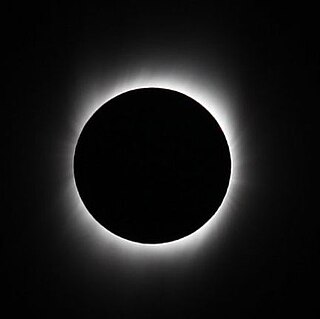
A total solar eclipse occurred on July 22, 2009 with a magnitude of 1.0799. It was the longest total solar eclipse during the 21st century, the longest total solar eclipse during the 3rd millennium will be on 16 July 2186. It lasted a maximum of 6 minutes and 38.86 seconds off the coast of Southeast Asia, causing tourist interest in eastern China, Pakistan, Japan, India, Nepal and Bangladesh. Its greatest magnitude was 1.07991, occurring only 6 hours, 18 minutes after perigee, with greatest eclipse totality lasting 6 minutes, 38.86 seconds during the Total Solar Eclipse of July 22, 2009.
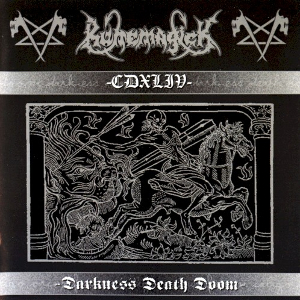
Darkness Death Doom is the sixth album by Runemagick. It was released in 2003 on Aftermath Music.
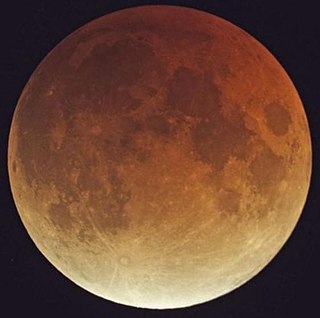
A total lunar eclipse occurred on the evening of Wednesday, February 20, and morning of Thursday, February 21, 2008. It was visible in the eastern evening sky on February 20 for all of North and South America, and on February 21 in the predawn western sky from most of Africa and Europe.

A total lunar eclipse took place on December 10, 2011. It was the second of two total lunar eclipses in 2011, the first having occurred on June 15. A lunar eclipse occurs when the moon is positioned just right in its orbit to pass through Earth's shadow.

A partial lunar eclipse took place on September 7, 2006, the second of two lunar eclipses in 2006. The tables below contain detailed predictions and additional information on the Partial Lunar Eclipse of 7 September 2006.

An annular solar eclipse occurred at the Moon’s ascending node of the orbit on Monday, January 26, 2009. A solar eclipse occurs when the Moon passes between Earth and the Sun, thereby totally or partly obscuring the image of the Sun for a viewer on Earth. An annular solar eclipse occurs when the Moon's apparent diameter is smaller than the Sun's, blocking most of the Sun's light and causing the Sun to look like an annulus (ring). An annular eclipse appears as a partial eclipse over a region of the Earth thousands of kilometres wide. It had a magnitude of 0.9282 and was visible from a narrow corridor beginning in the south Atlantic Ocean and sweeping eastward 900 km south of Africa, slowly curving northeast through the Indian Ocean. Its first landfall was in the Cocos Islands followed by southern Sumatra and western Java. It continued somewhat more easterly across central Borneo, across the northwestern edge of Celebes, then ending just before Mindanao, Philippines. The duration of annularity at greatest eclipse lasted 7 minutes, 53.58 seconds, but at greatest duration lasted 7 minutes, 56.05 seconds.

A penumbral lunar eclipse took place at the Moon’s ascending node on February 11, 2017, the first of two lunar eclipses in 2017. It was not quite a total penumbral lunar eclipse. It occurred the same day as comet 45P/Honda–Mrkos–Pajdušáková made a close approach to Earth. It also occurred on the Lantern Festival, the first since February 9, 2009. Occurring only 4.4 days after perigee, the moon's apparent diameter was larger.
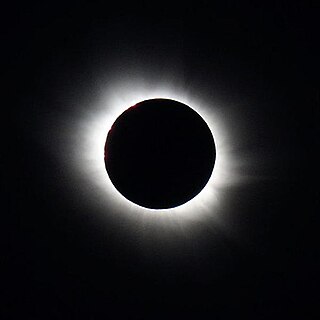
A total solar eclipse occurred on March 20, 2015. A solar eclipse occurs when the Moon passes between Earth and the Sun, thereby totally or partly obscuring the image of the Sun for a viewer on Earth. A total solar eclipse occurs when the Moon's apparent diameter is larger than the Sun's, blocking all direct sunlight, turning day into darkness. Totality occurs in a narrow path across Earth's surface, with a partial solar eclipse visible over a surrounding region thousands of kilometres wide. This total solar eclipse is notable in that the path of totality passed over the North Pole. Totality was visible in the Faroe Islands and Svalbard.

The solar eclipse of May 20, 2012 was an annular solar eclipse that was visible in a band spanning through Eastern Asia, the Pacific Ocean, and North America. As a partial solar eclipse, it was visible from northern Greenland to Hawaii, and from eastern Indonesia at sunrise to northwestern Mexico at sunset. The moon's apparent diameter was smaller because the eclipse was occurring only 32 1/2 hours after apogee.

The solar eclipse of January 6, 2019 was a partial solar eclipse that was visible in East Asia and North Pacific.
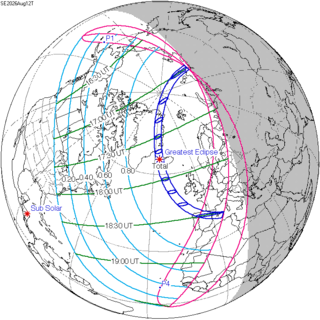
A total solar eclipse will occur on August 12, 2026, in North America and Europe. The total eclipse will pass over the Arctic, Greenland, Iceland, Atlantic Ocean and northern Spain. The points of greatest duration and greatest eclipse will be just 45 km off the western coast of Iceland by 65°10.3' N and 25°12.3' W, where the totality will last 2m 18s. It will be the first total eclipse visible in Iceland since June 30, 1954 and the only one to occur in the 21st century as the next one will be in 2196.

An annular solar eclipse occurred on May 30, 1984. A solar eclipse occurs when the Moon passes between Earth and the Sun, thereby totally or partly obscuring the image of the Sun for a viewer on Earth. An annular solar eclipse occurs when the Moon's apparent diameter is smaller than the Sun's, blocking most of the Sun's light and causing the Sun to look like an annulus (ring). An annular eclipse appears as a partial eclipse over a region of the Earth thousands of kilometres wide. Annularity was visible in Mexico, the United States, Azores Islands, Morocco and Algeria. It was the first annular solar eclipse visible in the US in 33 years. The moon's apparent diameter was near the average diameter because occurs 6.7 days after apogee and 7.8 days before perigee.

An annular solar eclipse occurred on January 4–5, 1992. A solar eclipse occurs when the Moon passes between Earth and the Sun, thereby totally or partly obscuring the image of the Sun for a viewer on Earth. An annular solar eclipse occurs when the Moon's apparent diameter is smaller than the Sun's, blocking most of the Sun's light and causing the Sun to look like an annulus (ring). An annular eclipse appears as a partial eclipse over a region of the Earth thousands of kilometres wide. Annularity was visible in the Federal States of Micronesia, Nauru, Kiribati, Baker Island, Palmyra Atoll, Kingman Reef, and southwestern California, including the southwestern part of Los Angeles.
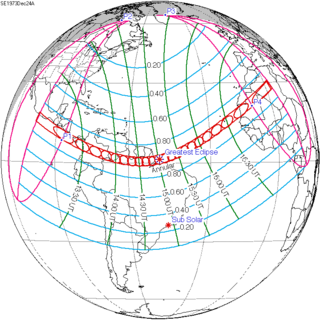
An annular solar eclipse occurred on December 24, 1973. A solar eclipse occurs when the Moon passes between Earth and the Sun, thereby totally or partly obscuring the image of the Sun for a viewer on Earth. An annular solar eclipse occurs when the Moon's apparent diameter is smaller than the Sun's, blocking most of the Sun's light and causing the Sun to look like an annulus (ring). An annular eclipse appears as a partial eclipse over a region of the Earth thousands of kilometres wide. Annularity was visible from southern Mexico, southwestern Nicaragua, Costa Rica including the capital city San José, Panama, Colombia including the capital city Bogotá, southern Venezuela, Brazil, southern Guyana, southern Dutch Guiana, southern French Guiana, Portuguese Cape Verde including the capital city Praia, Mauritania including the capital city Nouakchott, Spanish Sahara, Mali, and Algeria.

An annular solar eclipse occurred on December 14, 1955. A solar eclipse occurs when the Moon passes between Earth and the Sun, thereby totally or partly obscuring the image of the Sun for a viewer on Earth. An annular solar eclipse occurs when the Moon's apparent diameter is smaller than the Sun's, blocking most of the Sun's light and causing the Sun to look like an annulus (ring). An annular eclipse appears as a partial eclipse over a region of the Earth thousands of kilometres wide. Annularity was visible from French Equatorial Africa, Libya, Anglo-Egyptian Sudan including the capital city Khartoum, French Somaliland including the capital Djibouti City, British Somaliland including the capital city Hargeisa, the Trust Territory of Somaliland, the Maldives, Andaman and Nicobar Islands, Burma, Thailand including the capital city Bangkok, Cambodia, Laos, North Vietnam and South Vietnam, China, British Hong Kong, Taiwan, and Ryukyu Islands. It was the third central solar eclipse visible from Bangkok from 1948 to 1958, where it is rare for a large city to witness 4 central solar eclipses in just 9.945 years. This is the 20th member Solar Saros 141, and the last of first set of solar eclipses without a penumbral internal contact, the next event is the 1973 Dec 24 event, which is the first of 19 solar eclipses with a penumbral internal contact until 2298 Jul 09.

A total solar eclipse occurred on June 8, 1937. A solar eclipse occurs when the Moon passes between Earth and the Sun, thereby totally or partly obscuring the image of the Sun for a viewer on Earth. A total solar eclipse occurs when the Moon's apparent diameter is larger than the Sun's, blocking all direct sunlight, turning day into darkness. Totality occurs in a narrow path across Earth's surface, with the partial solar eclipse visible over a surrounding region thousands of kilometres wide. The path of totality crossed the Pacific Ocean starting in Gilbert and Ellice Islands on June 9th, and ending at sunset in Peru on June 8th (Tuesday).
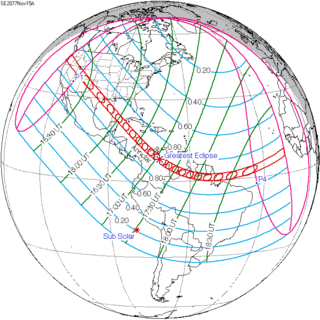
An annular solar eclipse will occur on Monday, November 15, 2077 with a magnitude of 0.9371. A solar eclipse occurs when the Moon passes between Earth and the Sun, thereby totally or partially obscuring the image of the Sun for a viewer on Earth. An annular solar eclipse occurs when the Moon's apparent diameter is smaller than the Sun's, blocking most of the Sun's light and causing the Sun to look like an annulus (ring). An annular eclipse appears as a partial eclipse over a region of the Earth thousands of kilometres wide. The path of annularity will cross North America and South America. This will be the 47th solar eclipse of Saros cycle 134. A small annular eclipse will cover only 94% of the Sun in a very broad path, 262 km wide at maximum, and will last 7 minutes and 54 seconds. Occurring only 4 days after apogee, the Moon's apparent diameter is smaller.

A total solar eclipse will occur on October 4, 2089. A solar eclipse occurs when the Moon passes between Earth and the Sun, thereby totally or partly obscuring the image of the Sun for a viewer on Earth. A total solar eclipse occurs when the Moon's apparent diameter is larger than the Sun's, blocking all direct sunlight, turning day into darkness. Totality occurs in a narrow path across Earth's surface, with the partial solar eclipse visible over a surrounding region thousands of kilometres wide. The tables below contain detailed predictions and additional information on the Total Solar Eclipse of 4 October 2089.
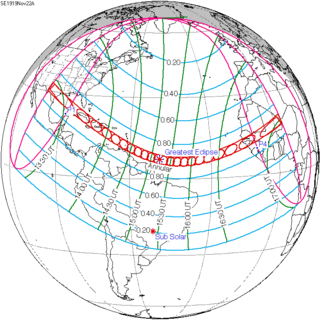
An annular solar eclipse occurred on November 22, 1919. A solar eclipse occurs when the Moon passes between Earth and the Sun, thereby totally or partly obscuring the image of the Sun for a viewer on Earth. An annular solar eclipse occurs when the Moon's apparent diameter is smaller than the Sun's, blocking most of the Sun's light and causing the Sun to look like an annulus (ring). An annular eclipse appears as a partial eclipse over a region of the Earth thousands of kilometres wide. It occurred in over half of North America, much of South America, a part of Western Europe and about a third of Africa.
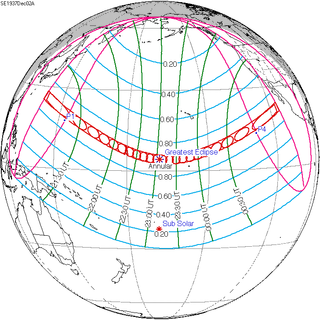
An annular solar eclipse occurred on December 2, 1937. A solar eclipse occurs when the Moon passes between Earth and the Sun, thereby totally or partly obscuring the image of the Sun for a viewer on Earth. An annular solar eclipse occurs when the Moon's apparent diameter is smaller than the Sun's, blocking most of the Sun's light and causing the Sun to look like an annulus (ring). An annular eclipse appears as a partial eclipse over a region of the Earth thousands of kilometres wide. Annularity was visible from Ogasawara, Tokyo and South Pacific Mandate in Japan, and Gilbert and Ellice Islands.




















